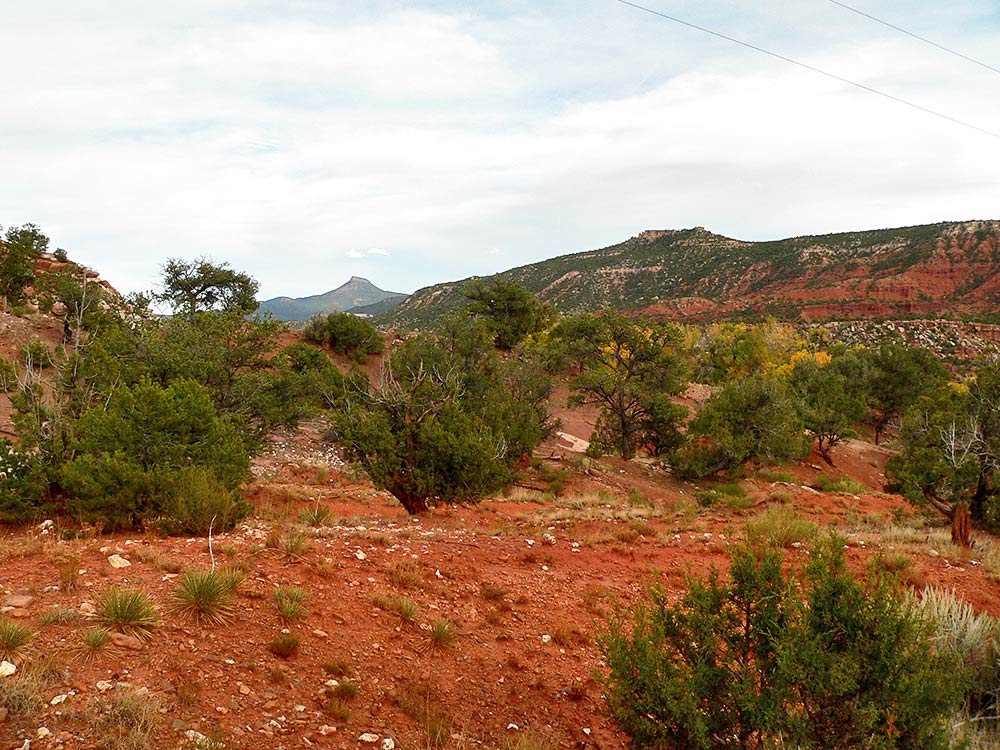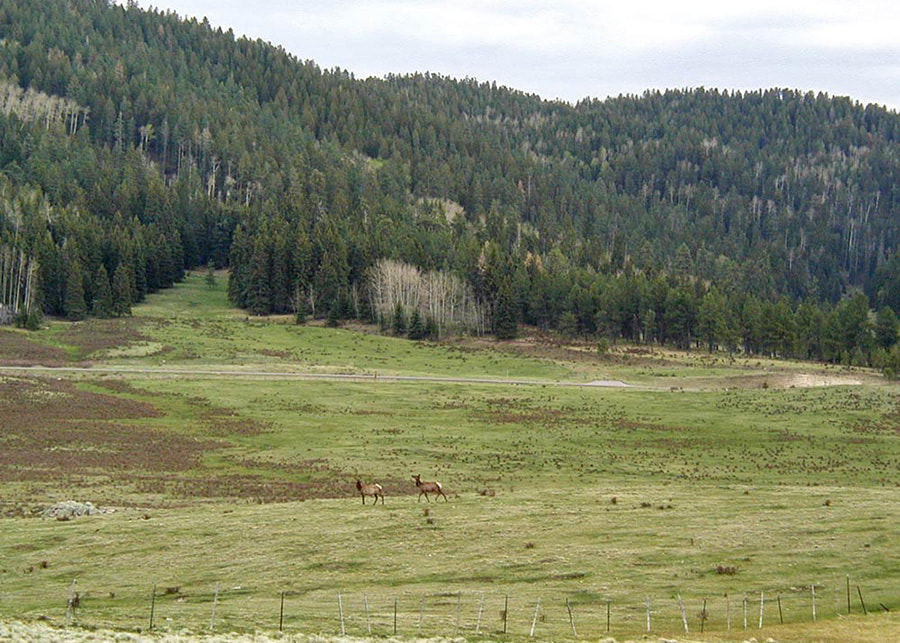|
When I moved to Abiquiú from Berkeley/California in 2000, I happily discovered many hiking trails almost right next door. Plaza Blanca was almost in my backyard, and Ghost Ranch was just ten minutes away. Once there one could climb up to Chimney Rock, explore the Box Canyon, and make it all the way to Kitchen Mesa – stunning hikes. The rocks one could find along the way were fascinating too, although I had no idea what they were; they looked like quartz crystals and mica and obsidian, but what were they really? I bought a book for New Mexico rockhounds and explored some of their recommended locations. Just past the Abiquiú Dam along Highway 96 towards Youngsville and Gallina one could find lots of agate, I learned. True enough; but when I moved to Coyote I found agates just about everywhere along the dirt roads and in the forests: near the Pedernal Mountain, around Cañones, along the Rio Puerco. Why not around Abiquiú? It took a long time before I got the answer to this question, simply because it hadn’t occurred to me to ask. Research about the agate around Coyote revealed a supervolcano known as Valles Caldera that erupted 1.25 million years ago in the Jemez Mountains, an area that is now known as the Valles Caldera National Preserve. I often went hiking near Valle Grande (the most famous section of Valles Caldera), but that’s really far away from Coyote — how did these agates end up here? Strictly speaking, “supervolcano” isn’t a scientific term. Geologists and volcanologists refer to a “Volcanic Explosivity Index” (VEI) of 8 and 7 when they describe super-eruptions. An increase of 1 indicates a 10 times more powerful eruption. VEI-8 are colossal events with a volume of 1,000 km3 (240 cubic miles) of erupted pyroclastic material (for example, ashfall, pyroclastic flows, and other ejecta). An example of a VEI-8 event is the eruption at Yellowstone (the Yellowstone Caldera) some 2.1 million years ago which had a volume of 2,450 cubic kilometers. VEI-7 volcanic events eject at least 100 km3 Dense Rock Equivalent (DRE). Valles Caldera belongs to the VEI-7 class of supermassive events (accounting for the countless agates in and around Coyote) and is situated within the Jemez Volcanic Field. The last eruption and collapse of the Valles Caldera occurred 1.25 million years ago, piling up 150 cubic miles of rock and blasting ash as far away as Iowa. Although huge in volume, the caldera-forming eruption in the Jemez Mountains was less than half the size of that which occurred at the Yellowstone Caldera system some 631,000 years ago. The name “caldera” comes from the Spanish word for “kettle”, “cooking pot”, or “cauldron”. Molten rock or magma begins to collect near the roof of a magma chamber bulging under older volcanic rocks. After an eruption begins and enough magma is ejaculated, the layer of rocks overlying the magma begins to collapse into the now emptied chamber because of the weight of the volcanic deposits. A roughly circular fracture develops around the edge of the chamber. In the case of Valles Caldera, the surrounding area continues to be shaped by ongoing volcanic activity, and an active geothermal system with hot springs and “fumaroles” (smoke plumes) exists even today.  Pyroclastic flows descend the south-eastern flank of Mayon Volcano, Philippines. Maximum height of the eruption column was 15 km above sea level, and volcanic ash fell within about 50 km toward the west. There were no casualties from the 1984 eruption because more than 73,000 people evacuated the danger zones as recommended by scientists of the Philippine Institute of Volcanology and Seismology. Photograph by C.G. Newhall on September 23, 1984 Source USGS.gov, Public Domain Even if it wasn’t quite “super”, it felt exciting to know that such an amazing (and unique, I thought) event had happened not very far from where I lived. Because I’m so ignorant as far as geology is concerned, I couldn’t really imagine what such an eruption would look like. But my interview in September with geologist and volcanologist Kirt Kempter reawakened my interest. He had explained WHY there were no agates to be found near Abiquiú, and had I lived in Coyote 1.25 million years ago when the Valles Caldera erupted, I wouldn’t have survived! Abiquiú was protected from the pyroclastic flow by mountains such as the Chicoma Peak and the Polvadera Peak, and a high plateau called the La Grulla Plateau. But more to the north and the northwest it could flow unhindered as far as at least 12 miles. AND: it can move as fast as 100 to 200 miles per hour. Almost impossible to imagine! Geological time usually is measured in really long time intervals, also hard to imagine – 1.25 million years ago? Can you picture this? – and yet, there are events that last maybe days only but change the landscape forever. There’s a difference between lava and pyroclastic flow: lava is the general term for magma (molten rock) that has been erupted onto the surface of the Earth and maintains its integrity as a fluid or viscous mass, rather than exploding into fragments. It usually flows slow enough to give people and animals near a volcanic eruption some time to escape. Pyroclastic flow, on the other hand, is more like a cloud: a mixture of hot gases, rock fragments, and ashes which moves at extremely high speeds. It wipes out anything living in its path and burns all organic matter. When I asked Kirt where I could find more information on the Valles Caldera, he kindly sent me a link to his six-part YouTube series: https://youtu.be/2gCm7et-N0s?si=GV1Ihq5NejM3RInD I highly recommend you watch this; it helps to get a better overall picture and has lots of fascinating facts. I will mention just a few more: Did you know that the area of the Jemez Mountains consists entirely of volcanic rocks, created by hundreds if not thousands of volcanic eruptions over the span of 14 to 15 million years? 350,000 years BEFORE the Valles Caldera eruption, a similar event happened: the Toledo Caldera (1.6 million years ago), in the same location, with the same magnitude. In his video Kirt shows us the different colorations in the landscape: the pyroclastic flow of the more recent Valles Caldera eruption has an orange-brown color. Below this one can see a light-beige volcanic rock layer without stratification, which is the remnant of the catastrophic pyroclastic flow of the Toledo Caldera. And below that is a thick layer of pumice and small particles, deposited by a single, extremely powerful vent which shot 20 kilometers or higher into the stratosphere – the beginning of the eruption of the Toledo Caldera. It’s amazing that scientists were able to figure out where these different streaks of colored rocks came from. One has to ask: Will the area of the Valles Caldera erupt again? While most of the media hype surrounding supervolcanoes focuses on Yellowstone where a VEI-8 event happened some 640,000 years ago which means that the next one could take place any moment or at least within the next 40,000 years, the Discovery Channel called Valles Caldera “a sleeping monster in the heart of New Mexico” but added in answer to the above question: No one knows. Duh.
8 Comments
Patty Kent
11/17/2023 07:52:10 am
As a fellow hiker and collector of rocks I know nothing about, I loved this article! Many thanks for all the research.
Reply
Jessica
11/24/2023 11:01:59 am
Yes, the rocks here are stunnung, aren't they. Glad you liked the article! Happy rock-hunting!
Reply
Christopher C Kunz
11/17/2023 09:24:12 am
Fantastic article! Thank you
Reply
Jessica
11/24/2023 11:03:54 am
Thank YOU, Christopher! It's always nice to know somebody liked the article.
Reply
11/24/2023 10:05:21 am
Thanks for the info, walked and enjoyed the beauty of the volcano several times.......will take a double take at the streaks of colored rocks when walking once more. Good reporting.
Reply
Jessica
11/29/2023 06:17:05 pm
Thanks, Wanda. Yes, one sees the colors with new eyes when one has some idea about the way they were formed. Enjoy your next viait!
Reply
11/28/2023 05:35:07 am
Absolutely incredible, interesting and facinating artical, Ready to watch Kirts video now! Thanks Jan!! So much research, appreciate you!
Reply
Jessica
11/29/2023 06:21:24 pm
Tina, I'm so happy that you liked the article. By all means, watch the video, it's fascinating.
Reply
Your comment will be posted after it is approved.
Leave a Reply. |
Submit your ideas for local feature articles
Profiles Gardening Recipes Observations Birding Essays Hiking AuthorsYou! Archives
October 2025
Categories
All
|




 RSS Feed
RSS Feed